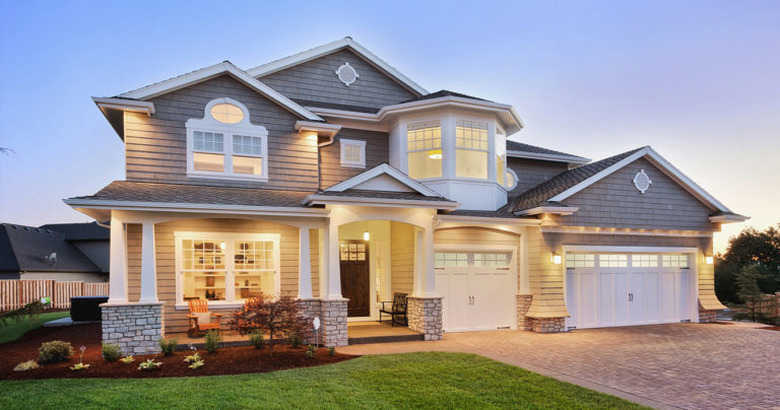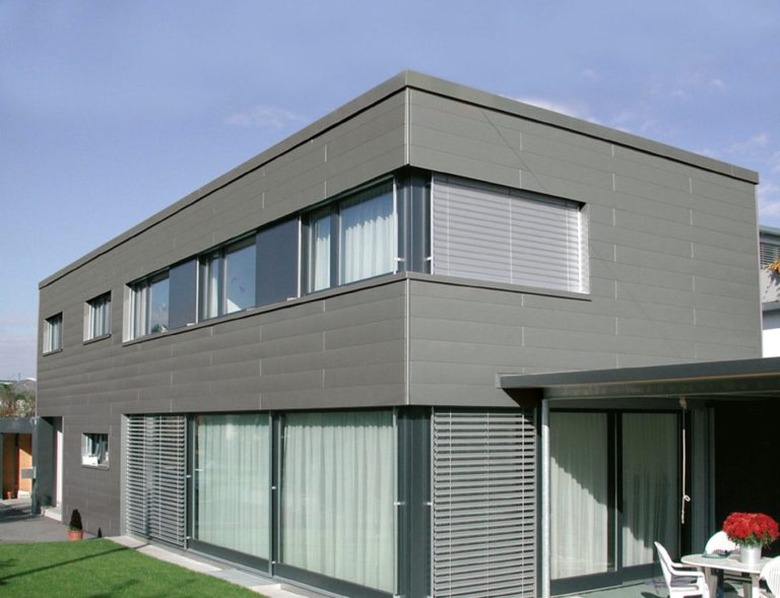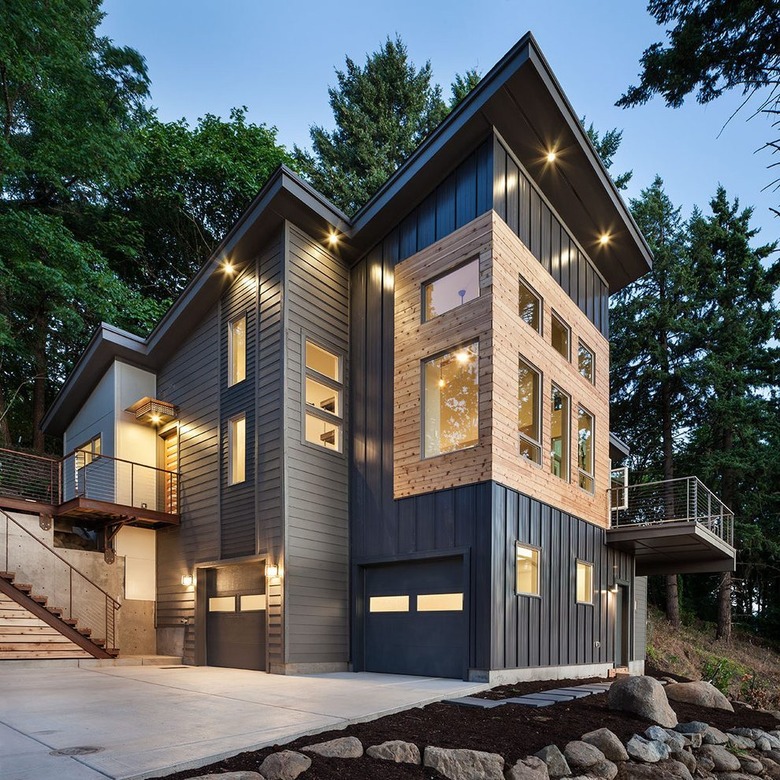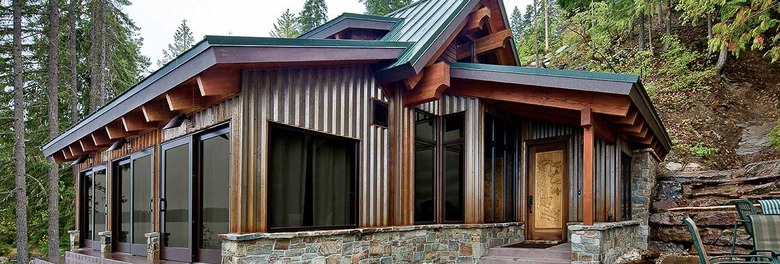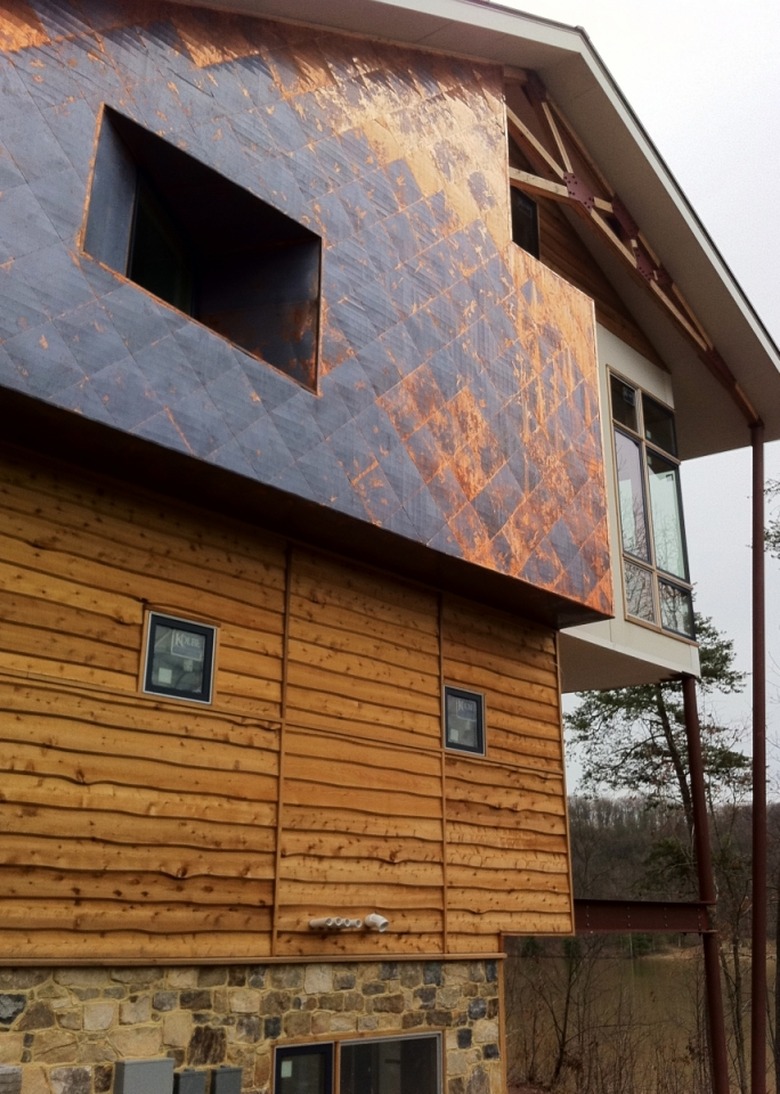An Introduction To Metal Siding
When someone mentions metal siding and you immediately think of flimsy aluminum tricked out to look like wood lap siding, you're not wrong. But today, metal siding can be much more than that. The term metal siding encompasses a broad range of styles, finishes, metals, and aesthetics with options ranging from cozy and traditional, to industrial and modern, to classical and elegant. There's a type of metal siding to complement any style home in practical and sometimes striking ways.
Aluminum Siding
Aluminum Siding
The low-budget faux wood aluminum siding commonly used to dress up an aging home at minimal expense is not as popular as it once was. While it looks fairly good from a distance, up close it can't compete with the real wood siding it presumes to imitate. Aluminum is a soft metal and the budget-grade siding is thin and dents easily, so before long the siding will begin to show distress from hail, from tree branches, and from normal activity around the house. Because the siding is assembled on the wall in interlocking panels, it's difficult to extract and replace a damaged one, and that's assuming you can even find a matching replacement. Manufacturers are constantly revising and updating their color choices and the color of the siding fades with time. Proper installation of any siding requires removal (and disposal) of the old siding. That adds expense to the siding project.
Because aluminum siding is thin, it's possible to install it over the old siding, covering over the decay and other problems that prompted the re-siding project in the first place. Where cost is the prime consideration, the temptation to cut corners is the greatest. If you are considering a home that has been inexpensively sided with aluminum (or with vinyl for that matter), make sure that it is not hiding old siding problems.
There are better grades of aluminum lap siding, shaped from heavier gauges of metal some even with backer board insulation to help the siding resist dents, add soundproofing and improve its R-value. Aluminum siding by itself offers little insulation from temperature extremes. Vertical panels that mimic board-and-batten style siding are also an option.
Aluminum siding comes from the factory pre-painted and that finish may last up to 10 years, but over time the color will begin to fade and the surface will get chalky. Aluminum siding can be repainted and it takes paint well, but first the surface must be completely cleaned to remove that chalky film.
So why is aluminum lap siding worthy of consideration? Aluminum siding is widely available, and installers are easy to find and offer competitive labor rates. Installed, aluminum siding costs about $9 to $12. Aluminum siding provides a good moisture barrier, it's insect proof and fireproof and it's completely recyclable. Unlike vinyl siding, aluminum won't end up in a landfill when it's served its usefulness—nothing is more recyclable than aluminum.
Steel Siding
Steel Siding
The alternative form of metal lap-board style siding is steel. Steel siding is tougher and more dent-resistant than aluminum but, unlike aluminum, steel is susceptible to rust. The siding arrives from the factory with a baked-on finish that will protect the steel as long as the finish is undamaged, but any scratches or abrasions are an open invitation to corrosion. Steel siding, like aluminum, is a poor insulator—not only from cold and heat but also from outside noises. As with aluminum, that shortcoming can be alleviated by adding a layer of insulation underneath the siding. While steel siding as a material is relatively economical—cheaper than aluminum—it's heavy and harder to handle than aluminum and increased installation costs often make up for the lower materials cost. Expect to pay $9 to $12 per square foot.
Beyond the familiar lap board style, steel siding is also available in forms ranging from rustic to starkly modern. On the rustic end is steel board-and-batten style siding, commonly associated with farmhouses and rural settings. Corrugated steel, often associated with agricultural and industrial buildings, has found applications in urban residences, as well. Corrugated is generally a heavier-gauge product than traditional steel siding, and the wavy corrugations add even more structural strength to the panels. Corrugated steel for siding is protected from rust by a painted or galvanized finish.
Cor-ten Steel
Cor-ten Steel
Cor-ten steel is a steel alloy designed to rust, but only up to a point. The rust on Cor-ten steel forms a protective skin that prevents further corrosion. Obviously, Cor-ten steel is meant to be left unpainted and its natural patina of oxidation is its signature look. Cor-ten's minimal maintenance requirements have made it an attractive choice for large municipal structures—bridges and towers—but increasingly, residential architects have embraced Cor-ten panels for their home designs.
Zinc and Copper Siding
While aluminum and steel are the most common and the most immediately economical forms of metal siding, they are not the only siding metals available, and in the long run, they may not even be the most cost-effective. Zinc and copper have a long history, both as siding and as roofing materials, and they are still a viable and attractive siding option today. Zinc siding costs about twice as much as aluminum or steel—about $20 per square foot—and copper will cost twice as much as zinc—about $35 per square foot—but whereas steel and aluminum over their lifespan will need periodic repainting and upkeep, zinc and copper need little or no maintenance and should last as long as your house.
Zinc siding is available in both horizontal and vertical configurations. Its response to aging and weather is to form a natural patina of zinc hydroxyl-carbonate that blocks moisture from penetrating. If that layer of patina is scratched and the underlying zinc is exposed, new patina forms over the scratch. In other words, zinc heals itself.
Copper, too, is available in a variety of siding styles—horizontal and vertical as well as interlocking flat panels. Like zinc, copper is non-corrosive and will last a lifetime. Over that lifetime, the copper will transition from shiny metallic to brown to verdigris green. The no-paint nature of copper and zinc means, of course, that there will be no opportunity to revisit your choice of siding or its color. The decision is permanent. While siding an entire house in copper may be an extravagant proposition, selective use of copper paneling in combination with other materials can provide sophisticated accent and dramatic contrast.
Weighing the Options
Weighing the Options
As with any type of siding, metal has its strengths and shortcomings. Any metal siding will give you good protection from moisture, resistance to fire, insects, and the effects of heat and cold. But aluminum dents easily, and steel can rust. Metal alone is a poor insulator. Zinc and copper require specialized installers and those may be hard to find. There are many more kinds of metal siding than you probably realized Before making any decision about metal siding, it's wise to talk to a knowledgeable consultant or contractor about your options.
